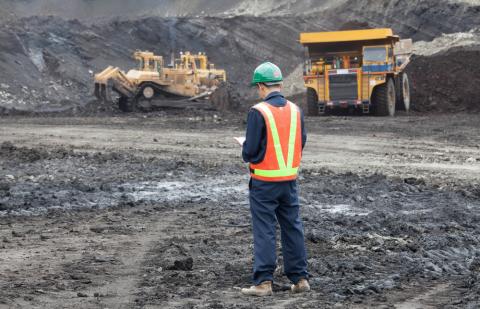Memo to the National Mining Association

 Recently the National Mining Association responded to several federal legislative proposals to reform the federal coal-leasing program. The association’s general critique includes this passage: “To begin with, those flying under the banner of assuring the public receives a fair return for the coal resources developed on federal lands paradoxically seek measures that are designed to keep coal in the ground.”
Recently the National Mining Association responded to several federal legislative proposals to reform the federal coal-leasing program. The association’s general critique includes this passage: “To begin with, those flying under the banner of assuring the public receives a fair return for the coal resources developed on federal lands paradoxically seek measures that are designed to keep coal in the ground.”
The NMA suggests also that higher royalty rates will increase electricity prices.
Here’s our response:
- First, the impetus for reform flows not from advocacy groups in Washington but from the failure of the federal government to perform any oversight of its coal lease program for 30 years. In 2012, official Washington had the temerity to actually review the program. One of the conclusions of the reviews was that reforms were in order, specifically for royalty rates, most particularly for exported coal. In a robust market the value of foreign coal sales are not captured by the existing royalty revenue system. That is, U.S. taxpayers receive zero on the value of exported coal. When the market is up, owners and coal producers alike should benefit, when it is down, all suffer.
- Second, the coal industry is in a state of collapse. It is losing market share. The federal coal lease program works on that theory that the industry is growing. The coal industry would like us to believe that economic growth and the growth of the coal industry are inextricably tied together. Not true. The coal sector has lost 88% of value while the Dow Jones Industrial Average continued to climb over the last five years. The future will be more of the same.
- Third, I agree with the NMA that geology and economics are the drivers of trends in the Powder River Basin. The cost of production is driving prices up. However, the price of coal is being driven down by market competition. The new drivers of price are low natural gas prices and competition from renewables and energy efficiency. The markets have change, and the rules of the federal lease program should be changed. Asking for increased royalty payments at a time of declining production is an attempt by the U.S. government to secure revenue from the coal that remains profitable. As an owner of the coal, the federal government is finally acting to get its share of an admittedly increasingly risky market. Unlike the coal industry, the federal government is a large owner with diverse interests. If the coal industry shrinks the federal government does not go out of business. It adjusts revenues, and other parts of the government begin to look to alternatives to coal, alternatives that are supplied by a robust global capital market. These new investments create jobs, taxes and economic activity in new areas of the country. When people and communities are harmed by these economic changes, good sense and help is in order, not invective.
- Fourth, a large owner like the federal government might want to lower royalty rates and its revenues if it received something back for the value deferred. The leadership of the coal industry is wed to the past: monopoly economics, technological Luddism and strong arm power politics. Coal is less relevant as an economic player. Its political power evaporates. The coal industry has been offered deals in Washington. They successfully fought climate legislation and their share prices have tumbled. They fight all forms of regulatory change that the public demands and the coal industry’s existence as a going concern erodes daily.
- Fifth, the National Mining Association wants streamlining of the coal lease program. This is by far the most paradoxical of their requests. The price of coal today offers no incentive for new mining. Coal producers are not showing up to lease auctions after a decade of demanding more leases. The coal isn’t worth mining. Rather than streamline a process to serve an industry that has lost control of the market. It is time for the federal owner of the land to restrict market access.
- Finally, the coal industry is quite critical of those involved with trying to think about new ways to reform the country’s energy choices. Its leaders point to what they say is flawed research and ideology-driven agendas. They complain about the conflation of climate change and federal coal lease policy. The industry fails to recognize that climate and environmental issues related to coal are here to stay. When you frustrate the issue in one place, the fact remains that we still live in a democracy where power is diffuse. The issue will find other venues like Congress, board rooms, banks, investment funds, editorial boards and the like. The public climate today is far better on coal policy than it has been for 30 years, most of a time in which there has been no research and no debate about this national resource.
SOME ADDITIONAL THOUGHTS ON COAL PRICES AND THE PARADOX OF CHEAP ELECTRICITY START WITH how the coal industry says it wants higher prices.
That was one of the core messages in the NMA’s letter the other day to Interior Secretary Sally Jewell on the status of coal reform in Washington. It is true from a financial perspective that only higher prices will improve profit margins. The industry’s efforts to cut costs are just not enough to improve margins and pay down legacy debt.
The coal industry paradoxically continues to oversupply the market, however, which only drives prices down. This trend is evident globally, where Chinese coal import reductions and India’s steps toward fewer coal imports are quelling the international market. Global thermal prices remain at historic lows and yet new ventures by the coal industry are being launched in Australia and elsewhere.
In the U.S., coal prices are low and margins are low. Too many companies are chasing a dwindling number of utility customers looking for coal. Utilities, in fact, are looking for more cheap natural gas and renewables to keep electricity prices low.
The industry claims that coal is cheap, yet it is losing market share to natural gas and renewables precisely because those sources are cheaper. The coal industry prayer for greater prices will contribute to rising electricity prices. Coal is not cheap, and it is getting more expensive.
From an investment point of view, coal needs a price spike in order to gather sufficient surplus revenues to pay down debt and stimulate new development. With the type of price restructuring going on in other energy markets and capital moving toward those areas, any price spike will be modest and insufficient to support the coal industry’s cost and debt structure. Short-term coal price worries have morphed now into an even bleaker longer-term outlook. This is the explanation behind coal industry bankruptcies, asset impairments and distressed sales.
History tells us something here. What has the U.S. coal industry done with high prices in the past? It has invested in new mining ventures here and abroad and on schemes to increase exports. Very little has been spent on efforts to improve coal’s competitive position. A lot of effort has been spent on frustrating innovation in the energy sector.
The National Mining Association now is asking the federal government to follow its lead and provide continued support for this industry. This would be a mistake.
Tom Sanzillo is IEEFA’s director of finance.











